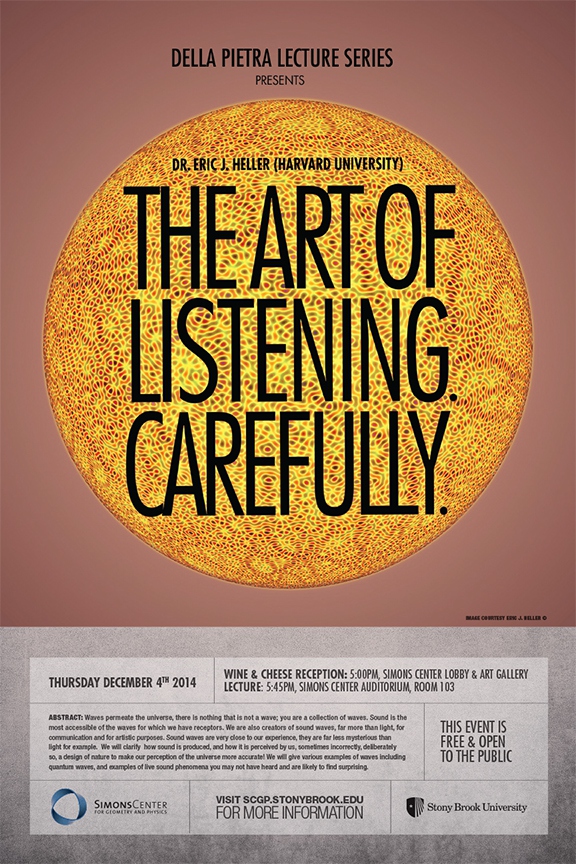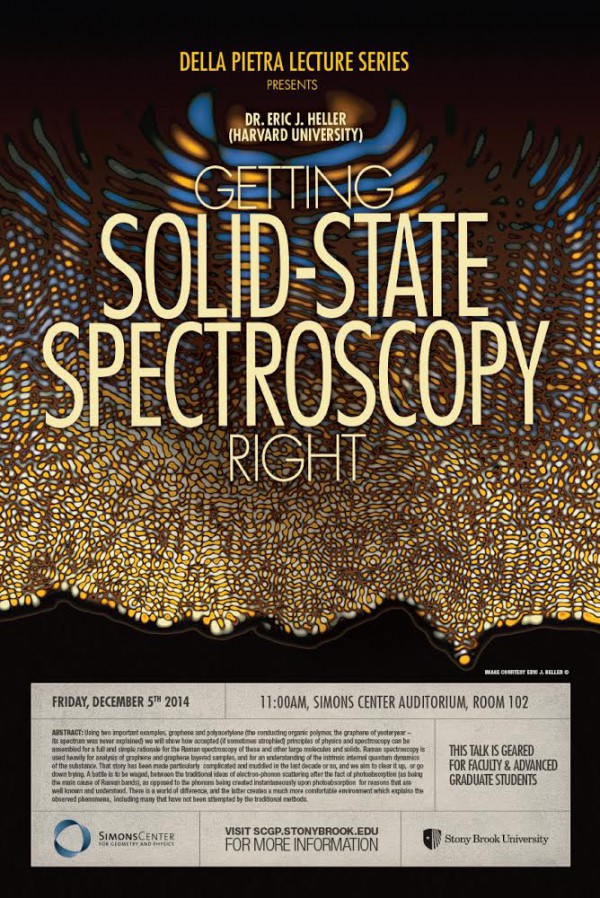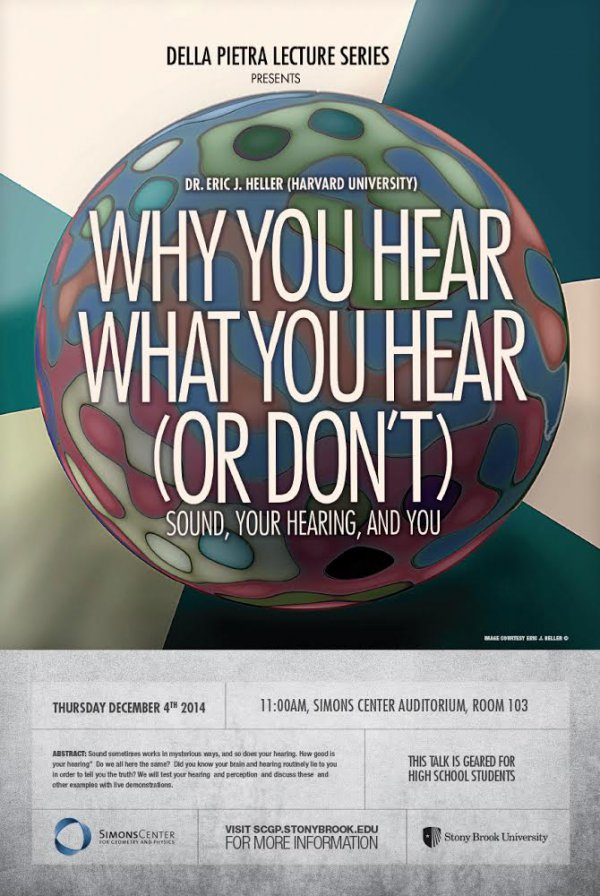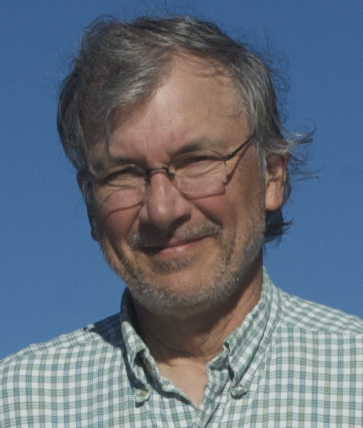General Public Lecture
Thursday December 4
Wine and Cheese Reception: 5:00pm, Simons Center Lobby and Art Gallery
Lecture: 5:45pm, Simons Center Auditorium, Room 103
Title: “The Art of Listening. Carefully.” Watch the Video
This event is in collaboration with the opening of the ‘Art and the Quantum Moment’ exhibition. For more information please visit: scgp.stonybrook.edu/archives/12754
ABSTRACT
Waves permeate the universe, there is nothing that is not a wave; you are a collection of waves. Sound is the most accessible of the waves for which we have receptors. We are also creators of sound waves, far more than light, for communication and for artistic purposes. Sound waves are very close to our experience, they are far less mysterious than light for example. We will clarify how sound is produced, and how it is perceived by us, sometimes incorrectly, deliberately so, a design of nature to make our perception of the universe more accurate! We will give various examples of waves including quantum waves, and examples of live sound phenomena you may not have heard and are likely to find surprising.

Technical Talk for Faculty and Advanced Graduate Students
Friday December 5
11:00am, Simons Center Lecture Hall, Room 102
Title: “Getting solid-state spectroscopy right” Watch the Video
ABSTRACT
Using two important examples, graphene and polyacetylene (the conducting organic polymer, the graphene of yesteryear – its spectrum was never explained) we will show how accepted (if sometimes atrophied) principles of physics and spectroscopy can be assembled for a full and simple rationale for the Raman spectroscopy of these and other large molecules and solids. Raman spectroscopy is used heavily for analysis of graphene and graphene layered samples, and for an understanding of the intrinsic internal quantum dynamics of the substance. That story has been made particularly complicated and muddled in the last decade or so, and we aim to clear it up, or go down trying. A battle is to be waged, between the traditional ideas of electron-phonon scattering after the fact of photoabsorption (as being the main cause of Raman bands), as opposed to the phonons being created instantaneously upon photoabsorption for reasons that are well known and understood. There is a world of difference, and the latter creates a much more comfortable environment which explains the observed phenomena, including many that have not been attempted by the traditional methods.

High School Lecture
Thursday December 4
11:00am, Simons Center Auditorium, Room 103
Title: “Why You Hear What You Hear (or don’t): Sound, your hearing, and you” Watch the Video
ABSTRACT
Sound sometimes works in mysterious ways, and so does your hearing. How good is your hearing” Do we all here the same? Did you know your brain and hearing routinely lie to you in order to tell you the truth? We will test your hearing and perception and discuss these and other examples with live demonstrations.
This talk is geared for high school students

 Dr. Eric Johnson Heller is the Abbott and James Lawrence Professor of Chemistry and Professor of Physics at Harvard University, where he received his Ph.D. in 1973. Dr. Heller is an elected Fellow of the American Academy of Arts and Sciences, the American Association for the Advancement of Science, the American Physical Society, The National Academy of Science, and the American Academy of Arts and Sciences. His research involves theoretical investigation of wave behavior, chaos and quantum mechanics, condensed matter physics including electron flow in semiconductors and electronic spectroscopy of crystals, including graphene.
Dr. Eric Johnson Heller is the Abbott and James Lawrence Professor of Chemistry and Professor of Physics at Harvard University, where he received his Ph.D. in 1973. Dr. Heller is an elected Fellow of the American Academy of Arts and Sciences, the American Association for the Advancement of Science, the American Physical Society, The National Academy of Science, and the American Academy of Arts and Sciences. His research involves theoretical investigation of wave behavior, chaos and quantum mechanics, condensed matter physics including electron flow in semiconductors and electronic spectroscopy of crystals, including graphene.
Dr. Heller has a lifelong interest in creating art as a way to communicate the semi-knowable world to larger groups of people than specialized research often allows. His recent art is inspired by the world we cannot see directly: the quantum realm of electrons, atoms, and molecules. The strange, often chaotic quantum domain yields forms, which Dr. Heller uses as a medium to create images attempting to convey the mystery of quantum physics. His prints are ultrahigh resolution, large format, and archival photographic media. Dr. Heller cites the artist Sol LeWitt as an important influence, whose meticulous and often geometric and algorithmic creations he admires.
For more information please visit: www.physics.harvard.edu/people/facpages/heller
 Dr. Eric Johnson Heller is the Abbott and James Lawrence Professor of Chemistry and Professor of Physics at Harvard University, where he received his Ph.D. in 1973. Dr. Heller is an elected Fellow of the American Academy of Arts and Sciences, the American Association for the Advancement of Science, the American Physical Society, The National Academy of Science, and the American Academy of Arts and Sciences. His research involves theoretical investigation of wave behavior, chaos and quantum mechanics, condensed matter physics including electron flow in semiconductors and electronic spectroscopy of crystals, including graphene.
Dr. Eric Johnson Heller is the Abbott and James Lawrence Professor of Chemistry and Professor of Physics at Harvard University, where he received his Ph.D. in 1973. Dr. Heller is an elected Fellow of the American Academy of Arts and Sciences, the American Association for the Advancement of Science, the American Physical Society, The National Academy of Science, and the American Academy of Arts and Sciences. His research involves theoretical investigation of wave behavior, chaos and quantum mechanics, condensed matter physics including electron flow in semiconductors and electronic spectroscopy of crystals, including graphene.



